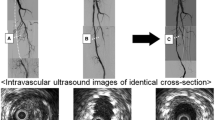Abstract
This study assessed the utility of intraluminal ultrasound imaging during deployment of a self-expanding vascular stent and quantitated changes in arterial morphology produced by the stent. Cross-sectional images of arterial lumens (n=50) were obtained before stenting, in-vitro (n=35) from formalin-preserved human superficial femoral arteries and in-vivo (n=15) from canine iliac arteries containing laser-induced eccentric stenoses. Comparison of ultrasound-derived vessel dimensions (minimum and maximum diameter and cross-sectional area) with histological morphometric analysis of corresponding vessel sites showed good correlation by linear regression analysis (r=0.930–0.987, p=0.001–0.005). Following stent placement, 23 intraluminal ultrasound images were obtained from the stented vessel sites (in-vitro n=15, in-vivo n=8) and were compared to prestented cross-sectional areas. In the in-vitro vessels there was a small increase (p=0.023) in area, but there was no change in the in-vivo arteries (p=0.6). To assess the effect of stenting on luminal shape (ellipticity), minimum/ maximum diameter ratios were compared before and after stent deployment. There was an increase in this ratio in the in-vitro vessels (p=0.001) but no change in the in-vivo arteries (p=0.2). We conclude that intraluminal ultrasound produces clear and accurate images of the location, shape and degree of arterial pathology, ensuring good stent: vessel size matching and immediate quantitative assessment of the effects of arterial stent placement.
Similar content being viewed by others
References
SCHATZ RA. Introduction to vascular stents.Cardiol Clin N Am 1988;6, 3:357–372.
McBRIDE W, LANGE RA, HILLIS LD. Restenosis after successful coronary angioplasty.N Engl J Med 1988;318: 1734–1737.
POTKIN BN, ROBERTS WC. Effects of percutaneous transluminal angioplasty on atherosclerotic plaques and relation of plaque composition and arterial size to outcome.Am J Cardiol 1988;62:41–48.
DOTTER CT. Transluminally placed coil-spring endarterial tube grafts: long-term patency in canine popliteal artery.Invest Radiol 1969;4:329–332.
WHITE RA, WHITE GH.Color Atlas of Endovascular Surgery. London, England; Chapman and Hall, Inc. 1990.
PENN IM, LEVINE SL, SCHATZ RA. Intravascular stents as an adjunct to endovascular intervention. In: MOORE WS, AHN SS (eds).Endovascular Surgery. Philadelphia: WB Saunders, 1989, pp 258–277.
WHITE RA. Intravascular Ultrasound. In:Current Practice of Interventional Radiology. Philadelphia: B.C. Decker, Inc, 1990.
STRANDNESS DE, SUMNER DS. The effect of geometry on arterial flow, Chapter 6. In:Hemodynamics for Surgeons New York: Grune and Stratton, 1975, pp 96–119.
Author information
Authors and Affiliations
About this article
Cite this article
Cavaye, D.M., Tabbara, M.R., Kopchok, G.E. et al. Intraluminal ultrasound assessment of vascular stent deployment. Annals of Vascular Surgery 5, 241–246 (1991). https://doi.org/10.1007/BF02329380
Issue Date:
DOI: https://doi.org/10.1007/BF02329380




